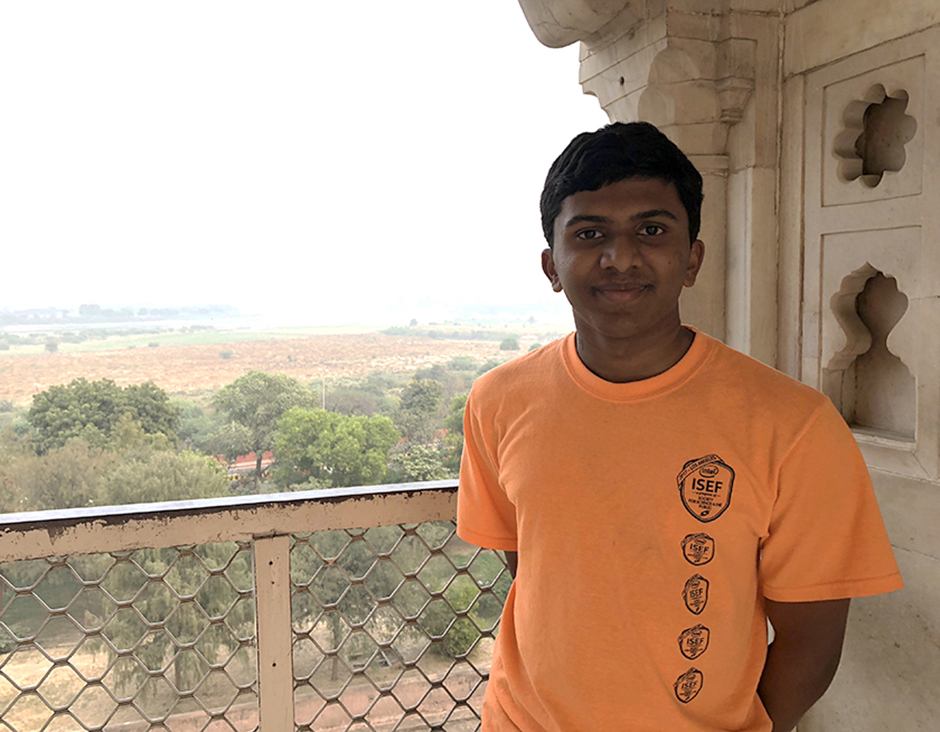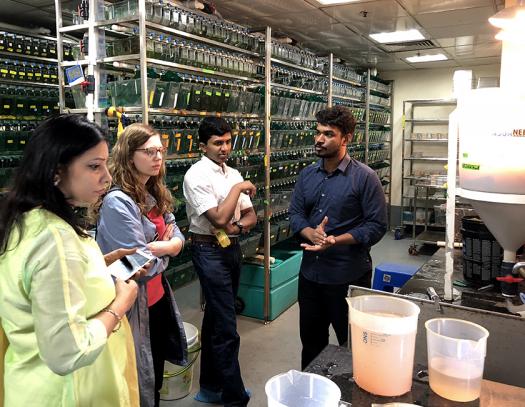American teen studying Zika brings research to India’s National Science Fair

This summer, two Intel International Science and Engineering Fair 2017 finalists traveled to India to present their research at the IRIS National Science Fair (IRIS) and explore the country. Rahul Subramaniam and Clara Wagner were afforded this opportunity as part of an award they received at Intel ISEF 2017, the Intel-Indo U.S. Science and Technology Forum Scientific and Cultural Visit to India Award.
Read on to learn more about Rahul’s experience.
THE BEST PART OF THE TRIP: Although I had visited India prior to this trip, because I have relatives in Bombay and Bangalore, this trip was like no other. It was eye opening, magical, and probably my favorite trip. Over the course of a week, this trip exposed me to the beauty of India in ways I had never known before, both in the form of monuments and temples, such as the Taj Mahal, Akshardham Temple, and the State Ballroom, as well as scientific fairs and research institutions. I also made several new friends while meeting fellow Indian scientists who are just as passionate about science as I am.

The institutions we visited were engaging and thought-provoking, with great thanks to the researchers and their state-of-the-art work. First we visited The Energy and Resources Institute (TERI), a sustainability retreat and institute that used a variety of clever design and construction methods to make their buildings as energy-efficient as possible.
Then, at the Indian Institute of Technology Delhi (IIT), we learned how a medical implant goes from engineering drawings to finished product, as well as the current research in fuel cells and microfluidics.
I met fellow Indian scientists who are just as passionate about science as I am.
At the National Institute of Immunology, my personal favorite, we discussed the labs’ cutting-edge research in various biological topics, ranging from infection and immunity to vaccines, before touring the institute and looking at some of the fanciest and coolest biological equipment I’ve ever seen. Finally, we visited the CSIR-Institute of Genomics & Integrative Biology (IGIB), where we visited several labs while talking about new frontiers in cancer research. Overall, I was amazed by the breadth and depth of the scientific research, and really enjoyed visiting the various institutions, with all of them conducting fascinating and critically necessary research.

ON ATTENDING A SCIENCE FAIR IN ANOTHER COUNTRY: Participating in IRIS exposed me to the cutting edge of what Indian students are researching in their respective schools and towns, and was the cornerstone of the entire trip. Prior to this, I had little experience with research being conducted by international students, but what I saw at IRIS completely blew me away. I found that many of the most interesting projects were those that solved problems in their own communities, such as a buoy that detected water quality in lakes, and a mathematical model to predict the spread of dengue.
I had the opportunity to talk to several of the participants and ask them about their projects, one of the highlights of the trip. Every single one of them was just as driven and passionate about science as I am.
I also interacted with several judges and members of the Scientific Research Committee at IRIS, something that rarely happens in the U.S. outside of the fair. They asked a variety of thought-provoking questions about my project while also helping me understand how science research works for Indian students.
The IRIS fair was the cornerstone of the entire trip.
THE IMPORTANCE OF SCIENCE FAIRS: Intel ISEF showed me the power that STEM has to change the world, and this has led me to promote STEM in my community, both among my peers and in my school. Science fairs are critically important because they allow the sharing of ideas and developments that science needs to grow as a field. They not only provide a venue for scientists to share their work and collaborate with others, but also inspire those outside STEM to get involved in science and try to make the world a better place.

HIS INTEL ISEF PROJECT: For my Intel ISEF project, I created and tested a mosquito trap that detects Zika virus in mosquito populations. This allows one to quarantine areas that could pose a health risk while running more detailed testing, preventing any number of people from being infected. The trap generates suction to draw mosquitoes inside, where they deposit the virus into a gold nanoparticle solution that changes color if the mosquitoes are carrying Zika virus. My mosquito trap gives results through a red-to-clear color change in only 15 minutes, as opposed to the current lab-based methods which can take weeks and require sophisticated training and equipment.
ADVICE FOR OTHERS INTERESTED IN STEM: My biggest piece of advice for young people interested in science is to never give up, no matter how large or daunting your problem may seem. If your experiments aren’t working as they should, keep working at it. Don’t be discouraged by a single issue or setback. Just keep working at it one step at a time.
The most interesting projects were those that solved problems in their own communities.
I would like to take this opportunity to officially express my greatest thanks and appreciation to Monika Madan, Chaitali Bhattachary, Sharon Kumar, and Lisa Icenroad for their tireless work to make the trip as smooth, enjoyable, and memorable as possible.


